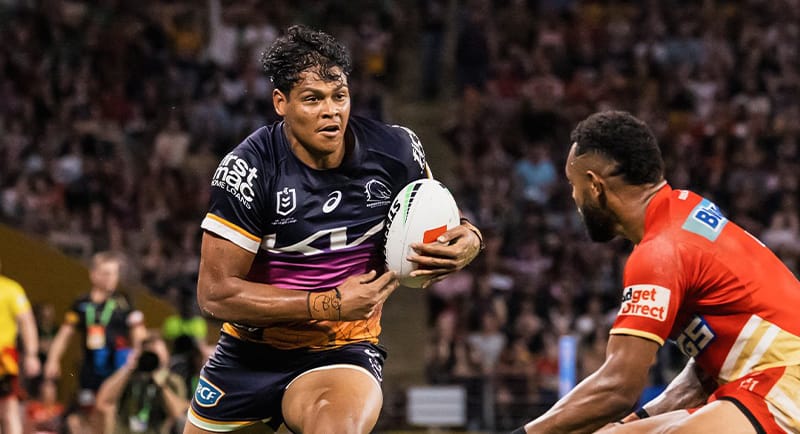The Dolphins were yet to take to the field back in August 2022 when Nine was sifting through the NRL draw to decide which games it would air. Fast forward seven months, and not even the most optimistic fans could have predicted the showdown that Brisbane Broncos v The Dolphins would end up being.
Usually during daylight savings the NRL pre-game is shown on 9Gem, and 9News Queensland leads into kickoff on the main channel. On Friday, with both teams entering the game undefeated, The Battle of Brisbane was so largely anticipated that 9News Queensland was cut by a whole half hour to fit the coverage on Nine’s main channel.
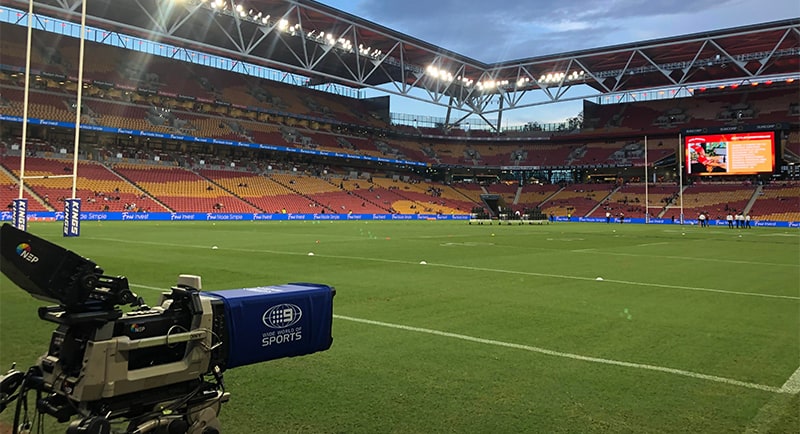
Gates open: The calm before the storm at Suncorp Stadium
Upwards of 51,000 people crammed into a sold out Suncorp Stadium, and 743,000 viewers watched across Nine (246,000 in Brisbane alone) to see the Broncos ultimately come out on top, going down to the wire to secure the 12-18 win off the back of a 100m try in the final minutes. As the crowd cheered and jeered, Mediaweek took a peek behind the scenes.
During breaks in the on-field action, Mediaweek caught up with Head of Nine Queensland, Kylie Blucher, and Head of Strategy WWOS, Simon Fordham.

Kylie Blucher and Simon Fordham
Queensland has always been a key area for the NRL, but as round four of the Dolphins’ debut year comes to a close, the numbers are beginning to paint a picture of just how significantly the game is growing.
Blucher: “The first three rounds are already up 30% year on year in Queensland, which just speaks to this rejuvenation through a new team coming in. I think the changes that the NRL made to the trial season and adding some incentive to win added to the enthusiasm and interest.
“The Dolphins have no doubt done a really good job across Queensland when it comes to driving membership and building noise. The [Wayne] Bennett factor can’t be underestimated, and that makes the Broncos lift, the Titans lift, and the Cowboys lift.”
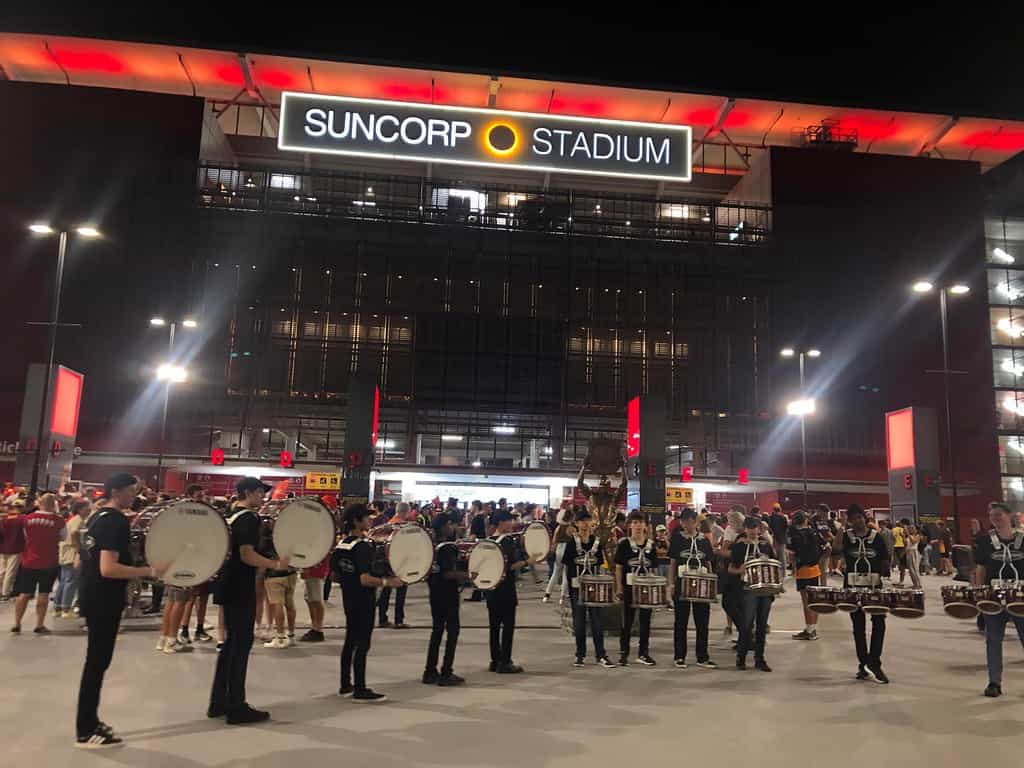
Drummers get the crowd excited outside Suncorp Stadium
When it comes to broadcasting for Queensland audiences, the team at Nine have a handful of things they need to keep in mind. Fordham describes the state as “parochial,” but also fiercely passionate when it comes to NRL, which means taking state pride into consideration.
Fordham: “When we have games in Queensland that feature Queensland based sides, we make sure that our commentary team has a really strong Queensland presence. For games called in Queensland, in most cases it will be Peter Psaltis, Paul Vautin, Cameron Smith, Jonathan Thurston, and Darren Lockyer. We want to make sure that when the audience in Queensland tune in, they’re seeing their heroes.
“We think that really reflects in the way that we’ve got quite loyal fans in Queensland for rugby league, but also I think those names really resonate given that they were the players that dominated through that dynasty period of the early 2000s.”
Blucher: “From my perspective, where Nine has nailed it this year – and it began last year, but it just feels like it’s cemented now – is that the commentary team has gelled so well. We are blessed to have that level of expertise, and the innate entertainers that they are.
“The game is just alive at the moment, there’s a there’s another level of energy that I feel is coming through the screen. It’s bigger and better than ever before.”
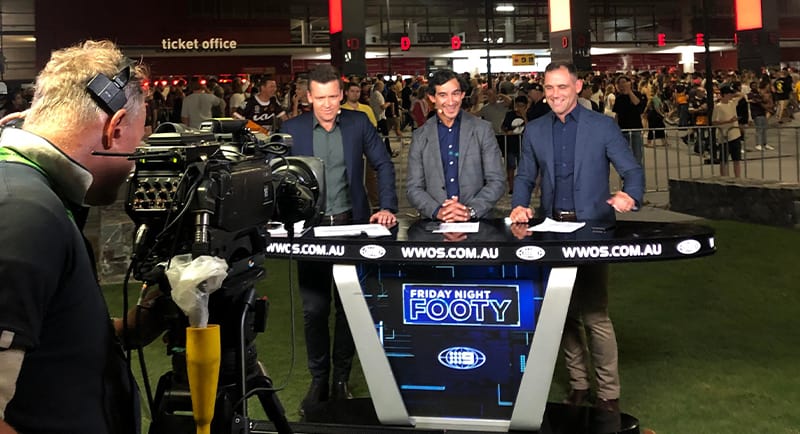
James Bracey, Jonathan Thurston, and Cameron Smith present the pre-game from outside the stadium
Blucher backs up the point about state pride, pointing to the fact that the Queensland market is an incredibly varied one.
Blucher: “From Nine’s perspective as a broadcaster, there are so many teams in Sydney that you can’t align yourself with any one team – you literally just support NRL as a total. In Queensland, you have to be attached to the teams because our regions are so diverse, it’s not a homogenous market.
“We have to stay connected to the teams our viewers love. We take on a really strong community sponsorship position with the three teams that are in southeast Queensland, because we have to reflect the diversity of our audience and ensure that we’re telling their stories, celebrating the wins, and commiserating when they lose.”
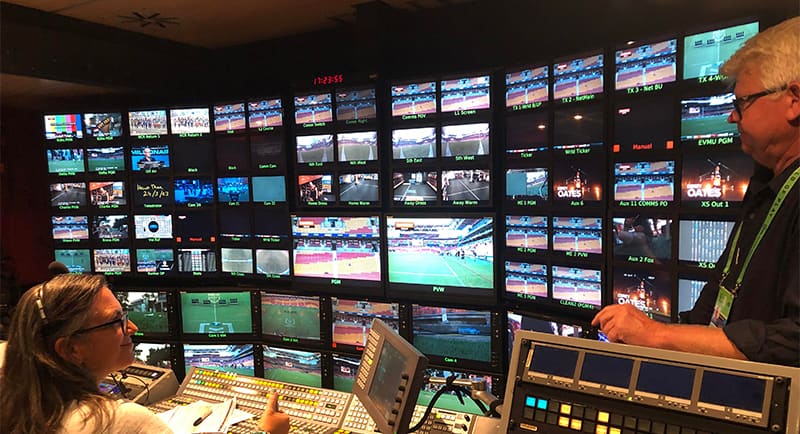
Inside the NEP OB Truck, overseen by EP of rugby league, Andrew Rodgers (right)
Sitting in Nine’s wet weather studio at Suncorp Stadium, a massive cheer goes up from the crowd while speaking to Blucher – Kurt Capewell has just crashed over the try line to score for the Broncos. The intensity of the game is impossible to miss, with Blucher pointing out that this is only the beginning for the NRL in Queensland this year.
Blucher: “The momentum is hard to stop now. Now that we’ve got this hometown rivalry, you couple that with magic round, and then you go into State of Origin. It feels like it’s bang, bang, bang – so the momentum is definitely there.”
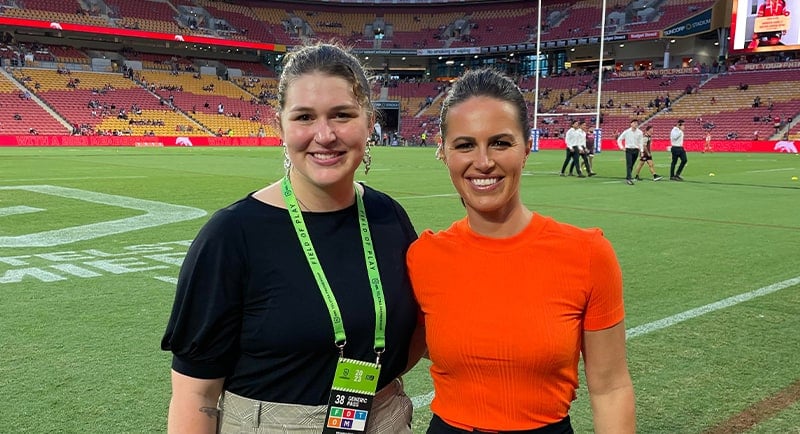
Mediaweek’s Tess Connery with Nine’s Danika Mason
For Fordham, making the most of this momentum looks like bringing more games to the region – and potentially another team.
Fordham: “We’re really committed to working with the NRL in growing the competition, and Queensland is a big part of that. We think there’s room for another team here in Queensland, and the Dolphins have been the perfect example.
“The more games we can get played featuring Queensland teams in Southeast Queensland, the better. The engagement in rugby league here is just next level, and the energy of the crowds has a material impact on the quality of the broadcasts that we make. It helps create atmosphere, it makes the commentary team rise, it makes the production team rise.”
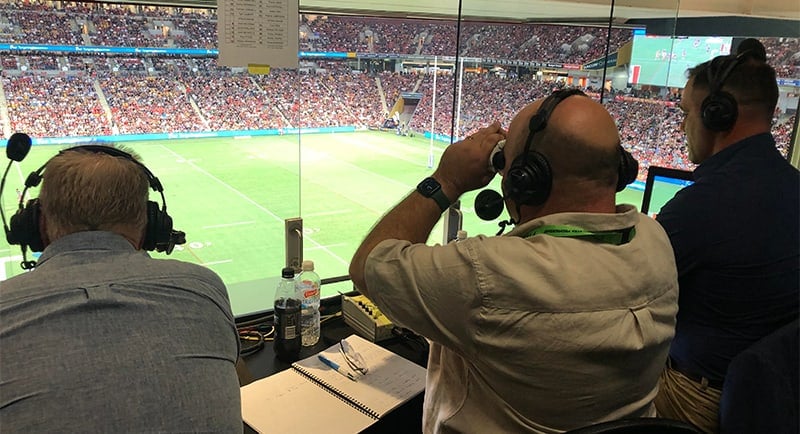
Paul Vautin, Peter Psaltis, and Cameron Smith call the game from the commentary box
Speaking about how the Nine broadcasts come together, Fordham mentions how a major point of difference for Nine’s NRL coverage comes from the fact that “it’s not necessarily about the two teams that are playing or the result, but a complete entertainment package for fans.”
Fordham: “One of the biggest differences is that Nine is talking to a really broad audience. It’s more than just the game and the result, we need to be able to tell really rich stories and build profiles and heroes and villains of these players. The best way to do that is through access.
“As broadcasters not only here in Australia, but across the world, we’re really pushing the envelope with the sporting federations, the clubs, and the teams around getting access to the playing group – whether that be through live interviews as close to kickoff as possible, extra camera angles, cameras in the change rooms, cameras on the buses, or talking to coaches in play. They’re all really valuable tools for us to make a really entertaining, engaging product.”
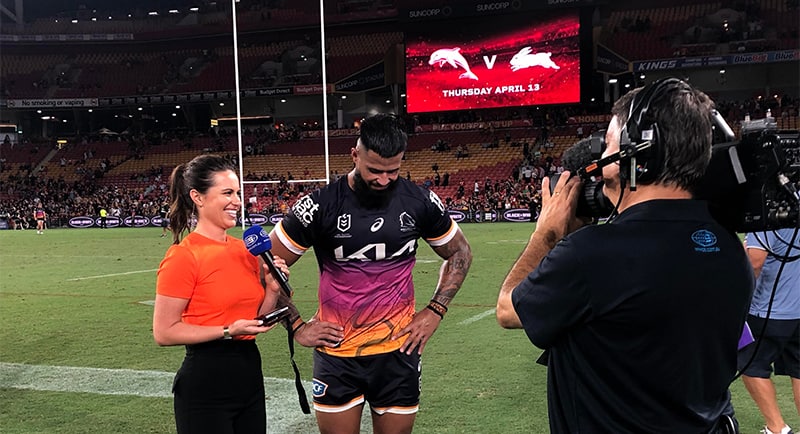
Danika Mason chats to Broncos player Payne Haas after the win
Expanding the NRLW
Another major growth area for Nine is the NRLW, with 2023 seeing the expansion of the women’s competition from six to 10 teams.
Fordham: “On average, we do about 100 NRL games a year – this year across NRLW and women’s State of Origin, we will do 50. That essentially represents 50% of the men’s games that will now be dedicated to the women’s game, which is a massive growth year on year. During the NRLW competition, Nine will be producing up to five games a week of NRLW, whereas for NRL we’re only doing three.
“The women’s game is a huge focus for us, we see it as a huge growth area. The audience profile on NRLW is completely different – it’s quite young and female, so we see it as a real opportunity to bring new audiences into rugby league.”
Blucher: “It’s great to see the growth in the participation and crowds. Being able to see the growth of that sport, I’m just so proud that Nine has invested not only in the number of games that we’re going to cover, but the talent that we are now discovering and supporting.
“What I love is that whether it’s the bloke’s game or the women’s game, you can have men and women calling on the sidelines – they’re all experts, they all know the sport inside out, and they’re really proud of what they’re doing.”
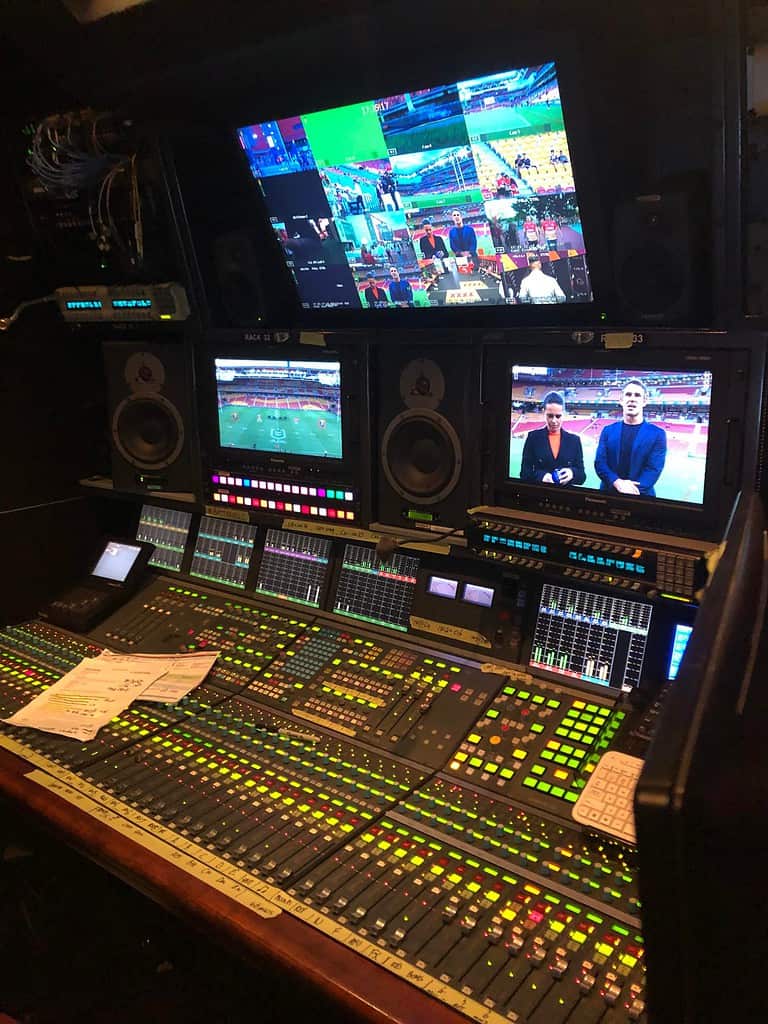
The NEP OB Truck audio set-up
“All rights, all platforms”: Future NRL broadcast deals
As audiences shift with technology changes – 70% of Nine’s rugby league BVOD audience watches through a smart television – so too do the broadcasters working to reach audiences wherever they are.
With the current NRL broadcast rights deal keeping the game with Nine and Foxtel until the end of 2027, Fordham says that the team have a very clear aim for future deals.
Fordham: “Our aim now is that any sports rights deal we do is all rights, all platforms, and exclusive where we can. We house those across linear channels, our streaming channels with 9Now, our subscription streaming platform Stan, radio, and mastheads.
“That is what we’ve done with the Olympics – the Olympics deal is all rights, all platforms. Our Australian Open tennis deal is all rights, all platforms. Rugby League is probably the only deal at the moment in our stable that isn’t all rights, all platforms – but in saying that, when the last subscription rights deal was done for rugby league, Stan Sport didn’t exist. I would say it’s definitely something we’ll look at for 2028.”
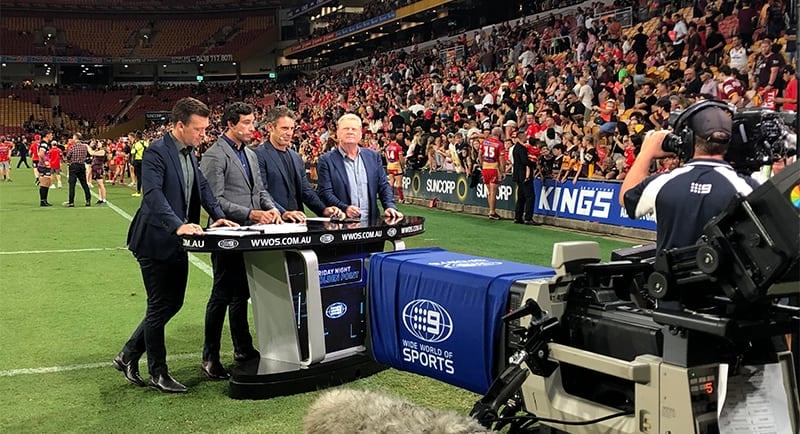
James Bracey, Johnathan Thurston, Brad Fittler, and Paul Vautin unpack the game from the field
See Also: “Nothing sells itself”: Nine’s Michael Stephenson on the commercial impact of the Olympic Games deal
